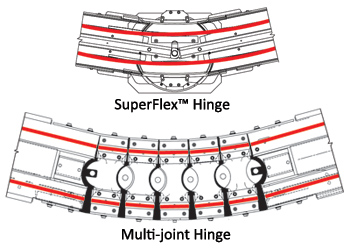

March 22 2018

Plastics orientation is the straightening and aligning of polymer chains that occurs in a variety of manufacturing processes used to produce many everyday plastic items. It is the intended outcome when stretching plastic sheet in width to produce transverse direction oriented (TDO) products such as shrink sleeve film, or when combined sequentially with machine direction orientation (MDO) to produce products such as BOPP film. This is accomplished by using a tenter frame to convey material through an oven while concurrently stretching it transversely at optimal process conditions to achieve the desired level of polymer orientation. One of the key components of this system that makes this possible is the tenter rail hinge, but not all hinges are created equal.
In a TDO machine, the rails that guide the tenter chain are typically manufactured in rigid straight lengths that are joined by a hinge that allows the rail sections to articulate relative to each other.These hinges are mounted on translating cross members that allow the distance of the rails relative to the centerline of the machine to be adjusted inward and outward to accommodate various widths of products and to achieve the desired rail profile to provide the required stretch ratio and strain rate.
The design of the tenter clips and rail hinges are critical in determining how much a tenter rail section will be able to articulate. Originally, these were constructed from a series of smaller sections of rail with sufficient clearance between segments to allow a small amount of articulation - on the order of 4° each. To achieve large diverging angles, many segments would be added to a multi-joint. This took up valuable space which reduced the access to the web and necessitated longer tenter frames. Because of this, multi-joints had a sizable negative impact on capital cost, and on operating expenses.
Parkinson Technologies’ Marshall and Williams Plastics brand developed SuperFlex™ hinges to overcome the limitations of traditional multi-joint hinges with the goal of providing a large articulation angle in a compact footprint at a competitive cost. SuperFlex hinges provide a smooth arc of travel for the tenter chain, supporting higher line speeds and reduced wear and lubrication requirements, and can articulate up to 20°. By using SuperFlex hinges at all rail joints in a tenter frame (something that would not have been practical using multi-joints) Marshall & Williams Plastics tenter frames have significant flexibility with respect to rail profile, making them more versatile from a process standpoint.
The importance of the rail hinge is critical to the finished product in an orientation system and the SuperFlex hinge adds an even higher level of performance at a more competitive cost. However, there is another component that is just as important. The tenter clip and chain, which was briefly mentioned above, also plays a critical role but again not all clip systems are created equal. In the follow-up article we’ll discuss the advantages and disadvantages of the most commonly used types, the sliding block and the bearing clip.